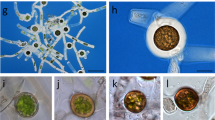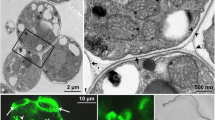Summary
The ultrastructure and composition of the extracellular matrices (ECMs) associated with germ tubes and appressoria ofColletotrichum lindemuthianum have been examined. Flexuous fibres (fimbriae), up to 6 μm long and 4–30 nm in diameter, protruded from the surface of germ tubes and appressoria. Anionic colloidal gold and lectin cytochemistry showed that ECMs of germ tubes and appressoria contain basic proteins, α-D-mannose and α-D-galactose residues. A monoclonal antibody, UB26, was raised to infection structures isolated from leaves ofPhaseolus vulgaris infected withC. lindemuthianum. UB26 recognised a protein epitope on two glycoproteins (Mr 133,000 and 146,000). Reductions in the Mr of these proteins after treatment with peptide-N-glycosidase and trifluoromethane sulphonic acid suggest that they carry N- and O-linked side-chains. Immunofluorescence and EM-immunogold labelling showed that glycoproteins recognised by UB26 were restricted to the ECMs around germ tubes and appressoria but fimbriae were not labelled. Unlike appressorial germ tubes formed in vitro, intracellular infection hyphae were not labelled, suggesting that the glycoproteins recognised by UB26 are not present on fungal structures formed within host cells. In liquid culture, these glycoproteins were not released into the medium, suggesting they are physically linked to the cell wall. Also, the glycoproteins were not removed from glass surfaces by ultrasonication. These results suggest that glycoproteins recognised by UB26 may be involved in the adhesion of germ tubes and appressoria to substrata. Our results show that the ECMs of germ tubes and appressoria differ markedly in structure and composition from those of conidia and intracellular hyphae, and that extracellular glycoproteins are associated with specific regions of the fungal cell surface.
Similar content being viewed by others
Abbreviations
- ECM:
-
extracellular matrix
- BPA:
-
Bauhinia purpurea agglutinin
- BSA:
-
bovine serum albumin
- DIC:
-
differential interference contrast
- FITC:
-
fluorescein isothiocyanate
- GNL:
-
Galanthus nivalis lectin
- GSI-B4 :
-
Griffonia simplicifolia isolectin B4
- HEPES:
-
(N-(2-hydroxyethyl)piperazine-N′-(2-ethanesulphonic acid)
- IIF:
-
indirect immunofluorescence
- IPC:
-
isopycnic centrifugation
- MAb:
-
monoclonal antibody
- PEG:
-
polyethylene glycol
- PBS:
-
phosphate buffered saline
- PNGase:
-
peptideN-glycosidase
- SDS-PAGE:
-
sodium dodecyl sulphate polyacrylamide gel electrophoresis
- TCS:
-
tissue culture supernatant
- TEM:
-
transmission electron microscopy
- TFMS:
-
trifluoromethane sulphonic acid
References
Akai S, Ishida N (1968) An electron microscopic observation on the germination of conidia ofColletotrichum lagenarium. Mycopathol Mycol Appl 34: 337–345
Bailey JA, O'Connell RJ, Pring RJ, Nash C (1992) Infection strategies ofColletotrichum species. In: Bailey JA, Jeger MJ (eds) Colletotrichum. Biology, pathology and control. CAB International, Wallingford, pp 88–120
Braun EJ, Howard RJ (1994) Adhesion of fungal spores and germlings to host plant surfaces. Protoplasma 181: 202–212
Day AW, Gardiner RB (1987) Fungal fimbriae. Stud Mycol 30: 333–349
Deising H, Nicholson RL, Haug M, Howard RJ, Mendgen K (1992) Adhesion pad formation and the involvement of cutinase and esterases in the attachment of uredospores to the host cuticle. Plant Cell 4: 1101–1111
Edge ASB, Faltynek CR, Hof L, Reichert LE, Weber P (1981) Deglycosylation of glycoproteins by trifluoromethane sulfonic acid. Anal Biochem 118: 131–137
Griffiths DA, Campbell WP (1973) Fine structure of conidial germination and appressorial development inColletotrichum atramentarium. Trans Br Mycol Soc 61: 529–536
Jones EBG (1994) Fungal adhesion. Mycol Res 98: 961–981
Jones GL, Bailey JA, O'Connell RJ (1995) Sensitive staining of fungal extracellular matrices using colloidal gold. Mycol Res 99: 567–573
Kaminskyj S, Day AW (1984) Effect of antifimbriai antisera on development of infection structures in the bean rust fungus. Phytopathology 74: 833
Kozar F, Netolitzky HJ (1978) Studies on hyphal development and appressorium formation ofColletotrichum graminicola. Can J Bot 56: 2234–2242
Lapp MS, Skoropad WP (1978) Nature of adhesive material ofColletotrichum graminicola appressoria. Trans Br Mycol Soc 70: 221–223
Mercure EW, Leite B, Nicholson RL (1994) Adhesion of ungerminated conidia ofColletotrichum graminicola to artificial hydrophobic surfaces. Physiol Mol Plant Pathol 45: 421–440
—, Kunoh H, Nicholson RL (1995) Visualization of materials released from adhered, ungerminated conidia ofColletotrichum graminicola. Physiol Mol Plant Pathol 46: 121–135
Moloshok TD, Leinhos GME, Staples RC, Hoch HC (1993) The autogenic extracellular environment ofUromyces appendiculatus urediospore germlings. Mycologia 85: 392–400
Nicholson RL, Epstein L (1991) Adhesion of fungi to the plant surface. Prerequisite for pathogenesis. In: Cole GT, Hoch HC (eds) The fungal spore and disease initiation in plants and animals. Plenum, New York, pp 3–23
O'Connell RJ (1987) Absence of a specialized interface between intracellular hyphae ofColletotrichum lindemuthianum and cells ofPhaseolus vulgaris. New Phytol 107: 725–734
— (1991) Cytochemical analysis of infection structures ofColletotrichum lindemuthianum using fluorochrome-labelled lectins. Physiol Mol Plant Pathol 39: 189–200
—, Nash C, Bailey JA (1992) Lectin cytochemistry: a new approach to understanding cell differentiation, pathogenesis and taxonomy inColletotrichum. In: Bailey JA, Jeger MJ (eds) Colletotrichum. Biology, pathology and control. CAB International, Wallingford, pp 67–87
Pain NA, O'Connell RJ, Bailey JA, Green JR (1992) Monoclonal antibodies which show restricted binding to fourColletotrichum species:C. lindemuthianum, C. malvarum, C. orbiculare andC. trifolii. Physiol Mol Plant Pathol 41: 111–126
—, Green JR, Gammie F, O'Connell RJ (1994a) Immunomagnetic isolation of viable intracellular hyphae ofColletotrichum lindemuthianum (Sacc. & Magn.) Briosi & Cav. from infected bean leaves using a monoclonal antibody. New Phytol 127: 223–232
—, O'Connell RJ, Mendgen K, Green JR (1994b) Identification of glycoproteins specific to biotrophic intracellular hyphae formed in theColletotrichum lindemuthianum—bean interaction. New Phytol 127: 233–242
— —, Green JR (1995) A plasma membrane-associated protein is a marker for differentiation and polarisation ofColletotrichum lindemuthianum appressoria. Protoplasma 188: 1–11
Pascholati SF, Deising H, Leite B, Anderson D, Nicholson RL (1993) Cutinase and non-specific esterase activities in the conidial mucilage ofColletotrichum graminicola. Physiol Mol Plant Pathol 42: 37–51
Perry J, Gilligan M, Green E, Docherty H, Heath D (1990) Monoclonal antibodies to ROS 17/2.8 cells recognise antigens, some of which are restricted to osteoblasts and chondrocytes. J Bone Mineral Res 5: 187–200
Pielken P, Stahmann P, Sahm H (1990) Increase in glucan formation byBotrytis cinerea and analysis of the adherent glucan. Appl Microbiol Biotechnol 33: 1–6
Poon NH, Day AW (1974) Fimbriae in the fungus,Ustilago violacea. Nature 250: 648–649
Rghei NA, Castle AJ, Manocha MS (1992) Involvement of fimbriae in fungal host-mycoparasite interaction. Physiol Mol Plant Pathol 41: 139–148
Romantschuk M (1992) Attachment of plant pathogenic bacteria to plant surfaces. Annu Rev Phytopathol 30: 225–243
Ruel K, Joseleau J-P (1991) Involvement of an extracellular glucan sheath during degradation ofPopulus wood byPhanerochaete chrysosporium. Appl Environ Microbiol 57: 374–384
Ruiz-Herrera J (1992) Fungal cell wall: structure, synthesis and assembly. CRC Press. Boca Raton
Sela-Buurlage MB, Epstein L, Rodriguez RJ (1991) Adhesion of ungerminatedColletotrichum musae conidia. Physiol Mol Plant Pathol 39: 345–352
Sherriff C, Whelan MJ, Arnold GM, Lafay J-F, Brygoo Y, Bailey JA (1994) Ribosomal DNA sequence analysis reveals new species groupings in the genus Colletotrichum. Exp Mycol 18: 121–138
Stafford CJ, Green JR, Callow JA (1992) Organisation of glycoproteins into plasma membrane domains onFucus serratus eggs. J Cell Sci 101: 437–448
Uchiyama T, Ogasawara Y, Nanba Y, Ito H (1979) Conidial germination and appressorial formation of the plant pathogenic fungi on the coverglass or cellophane coated with various lipid components of plant leaf waxes. Agric Biol Chem 43: 383–384
Van Damme EJM, Allen AK, Peumans WJ (1987) Isolation and characterisation of a lectin with exclusive specificity towards mannose from snowdrop (Galanthus nivalis) bulbs. FEBS Lett 215: 140–144
Van Dyke CG, Mims CW (1991) Ultrastructure of conidia, conidium germination, and appressorium development in the plant pathogenic fungusColletotrichum truncatum. Can J Bot 69: 2455–2467
Wood C, Kabat EA, Murphy LA, Goldstein IJ (1979) Immunochemical studies of the combining sites of the two isolectins, A4 and B4, isolated fromBandeiraea simplicifolia. Arch Biochem Biophys 198: 1–11
Xu J, Day AW (1992) Multiple forms of fimbriae on the sporidia of corn smut,Ustilago maydis. Int J Plant Sci 153: 531–540
Young DH, Kauss H (1984) Adhesion ofColletotrichum lindemuthianum spores toPhaseolus vulgaris hypocotyls and to polystyrene. Appl Environ Microbiol 47: 616–619
Author information
Authors and Affiliations
Rights and permissions
About this article
Cite this article
Pain, N.A., Green, J.R., Jones, G.L. et al. Composition and organisation of extracellular matrices around germ tubes and appressoria ofColletotrichum lindemuthianum . Protoplasma 190, 119–130 (1996). https://doi.org/10.1007/BF01281311
Received:
Accepted:
Issue Date:
DOI: https://doi.org/10.1007/BF01281311




